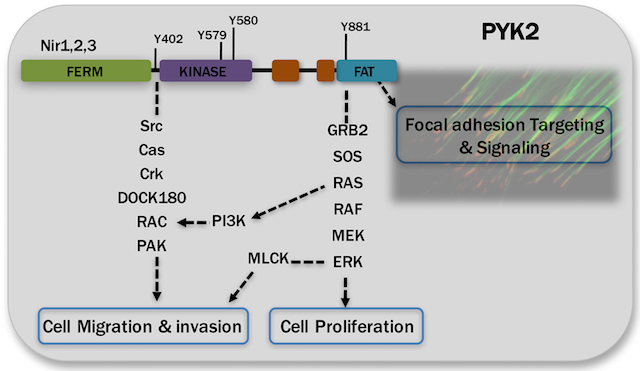We apply multidisciplinary experimental approaches using expression profiling, reverse phase protein array (RPPA), and imaging techniques to monitor dynamic changes in signaling networks in response to cell stimuli and different signaling perturbations (drug/ genetic manipulation). This analysis helps to define signaling rewiring and adaptive responses. Ongoing studies:
- Signaling by EGFR, cMet, AXL: we focus on signaling of three RTKs which are considered as therapeutic targets for TNBC: EGFR, cMet and AXL. We investigate the crosstalk of their signaling pathways, their association with drug resistance, and their role in the crosstalk between the tumor cells and cells of the tumor microenviroment.
- Signaling by PYK2 and FAK in TNBC malignancy: we initially isolated the non-receptor tyrosine kinase PYK2 and demonstrated its key roles in signaling pathways of different growth factors, hormones, and extracellular matrix proteins (Lev et al., 1995). This discovery opened a new field of extensive research (Dikic et al., 1996, Litvak et al., 2000, Tian et al., 2000), and PYK2 is now recognized as a key regulator of multiple cellular processes, including cell growth, migration, and invasion (Fig. 1). PYK2 is highly expressed in different human tumors and is often associated with poor prognosis, extensive metastasis and reduced survival. We have recently showed a significant correlation between PYK2 expression and breast cancer metastasis (Verma et al., 2015), and more recently found that co-targeting of PYK2 and EGFR could have a therapeutic benefit for a subset of TNBC patients (Verma et al., 2017). Most strikingly, we found that PYK2 regulates the endocytic trafficking and/or degradation of multiple cell surface proteins including RTKs, and consequently modulates RTKs-associated drug resistance. We seek to define the role of PYK2 and FAK in TNBC subtypes and explore their potential as therapeutic targets.
- Role of PYK2 in the crosstalk between TNBC and Tumor associated macrophages (TAM): we investigate the role of PYK2 in the crosstalk signaling between TNBC cells and TAM applying in vitro and in vivo models.
- Epithelial-mesenchymal transition (EMT) and TNBC metastasis: EMT is an essential developmental process implicated in cancer invasion and metastasis. It is a multi-step process that associates with activation of the Snail/Slug, Zeb and/or Twist transcription factors. Different signaling pathways trigger EMT in TNBC. We have recently found that the tyrosine kinase PYK2 (Verma et al., 2015) as well as the lipid-transfer protein Nir2 (Keinan et al., 2014) positively regulate EMT in TNBC. We are seeking to define the predominant signaling pathways that regulate EMT in metastatic TNBC subtypes and assess their impact on TNBC invasion and metastasis in animal models.

The non-receptor tyrosine kinase PYK2 and its downstream signaling pathways that regulate cell proliferation, migration and invasion. PYK2 contains several structural domains including, an N-terminal FERM domain that interacts with the Nir proteins (Nir1, Nir2 and Nir3), a central kinase domain, two short proline rich domains (brown) that interact with multiple SH3 containing proteins, and a C-terminal focal adhesion targeting (FAT) domain. Its major autophosphorylation site Y402 and the two tyrosine residues Y570 and Y580 in its kinase domain, which provides a binding site for Src (Y402) and are subsequently phosphorylated by Src (Y570 and Y580), respectively, are critical for its kinase activity. pY881 binds the SH2 domain of GRB2.


